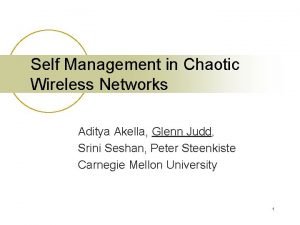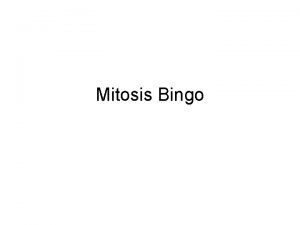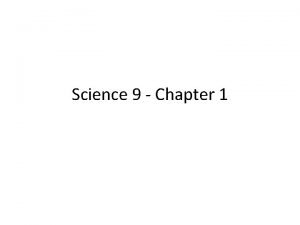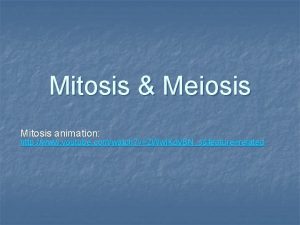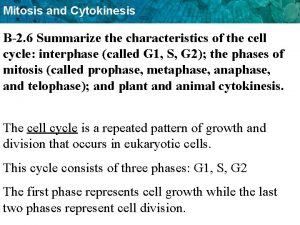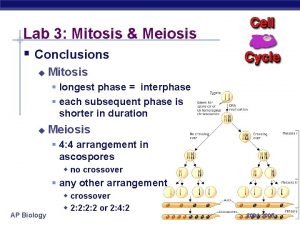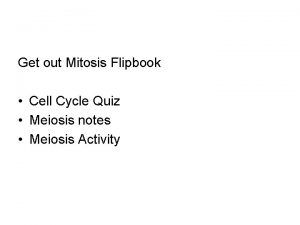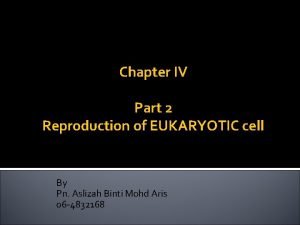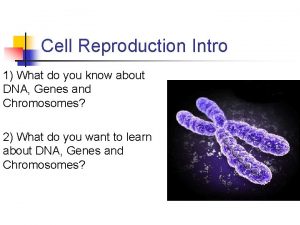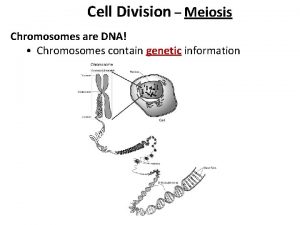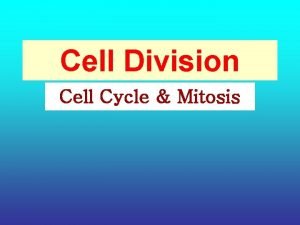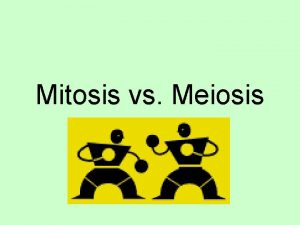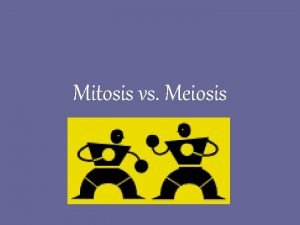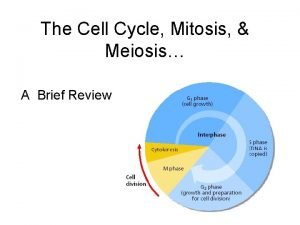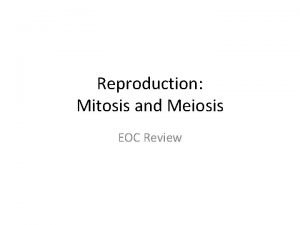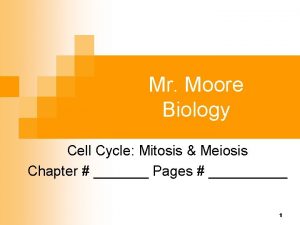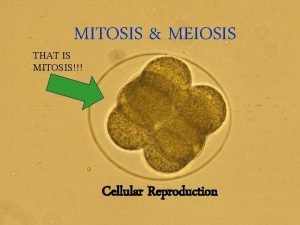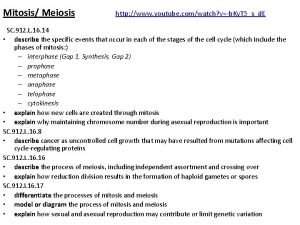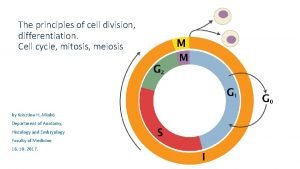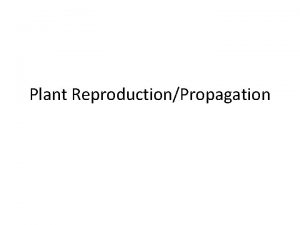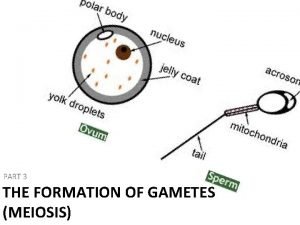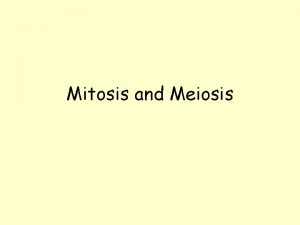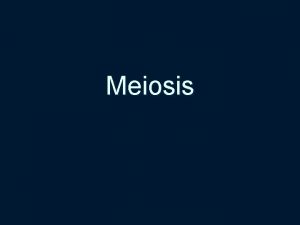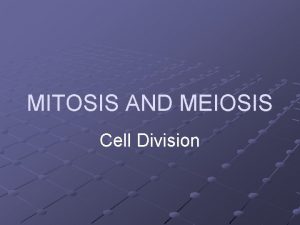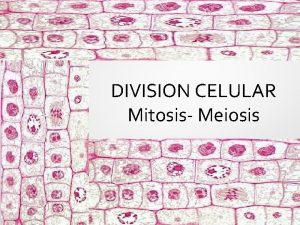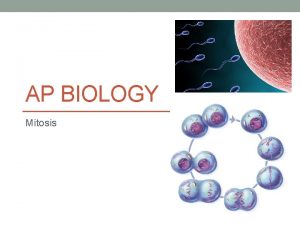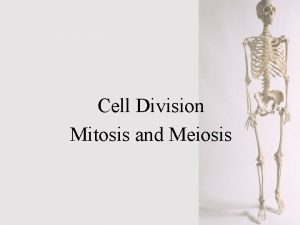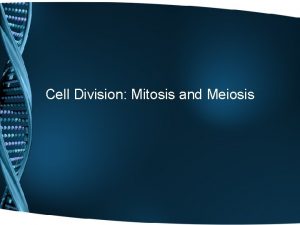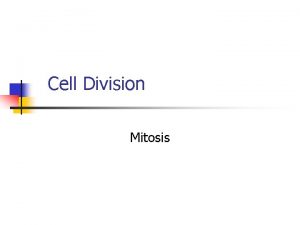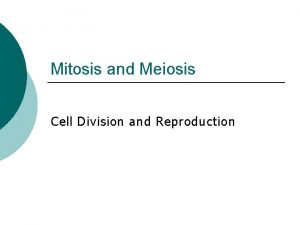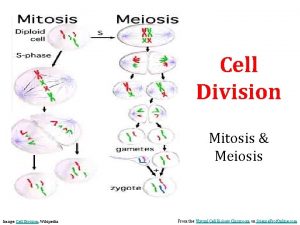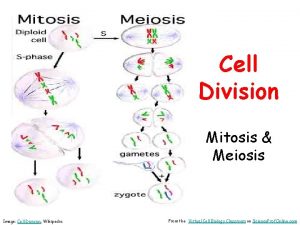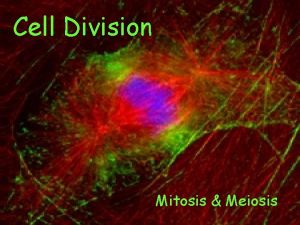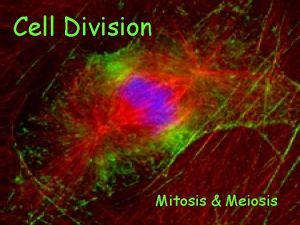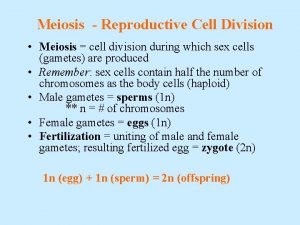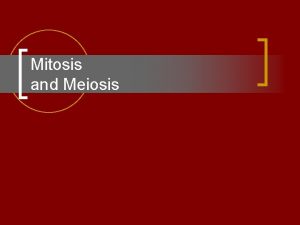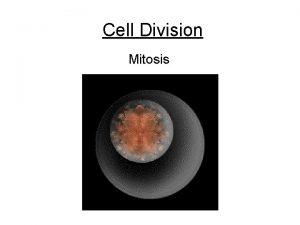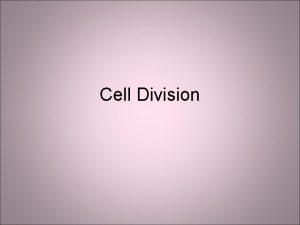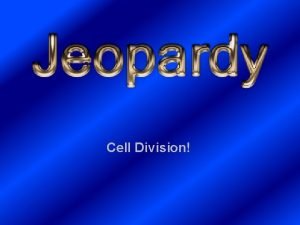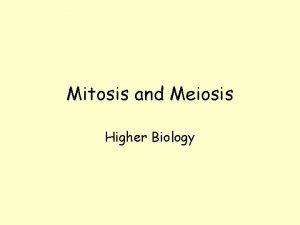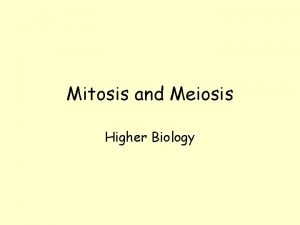MITOSIS AND MEIOSIS Cell Division DR SHUCHI SHARMA








































- Slides: 40

MITOSIS AND MEIOSIS Cell Division DR. SHUCHI SHARMA

MITOSIS Organisms grow by the addition of cells In multicellular organism some of these cells perform functions different from other cells.

• The process of a cell becoming different is differentiation. • Under normal conditions once an animal cell becomes specialized it can no longer form an entire organism, however plant cells are totipotent and any cell can form an entire plant.

WHEN DO CELLS DIVIDE? • Most limiting factor in size is the size of the cell membrane. – Cells must obtain nutrients – As volume increases, cell surface area does not increase as greatly – Larger cells require a larger surface area for survival

Cell Division vs. Nuclear Division Cytokinesis: The actual division of the cell into two new cells. Mitosis: The division of the nucleus of the cell into two new nuclei.

Terminology • Chromatin - thin fibrous form of DNA and proteins • Sister chromatids- identical structures that result from chromosome replication, formed during S phase

ANATOMY OF A CHROMOSOME p -arm centromere q-arm chromatids telomere • Centromere - point where sister chromatids are joined together • P=short arm; upward • Q=long arm; downward • Telomere-tips of chromosome

Cell cycle - sequence of phases in the life cycle of the cell

Cell cycle has two parts: growth and preparation (interphase) cell division mitosis (nuclear division) cytokinesis (cytoplasm division)

Interphase Occurs between divisions Longest part of cycle 3 stages


Interphase G 1 or Gap 1 The cell just finished dividing so in Gap 1 the cell is recovering from mitosis S or Synthesis stage DNA replicates • G 2 or Gap 2 – This is preparation for mitosis – Organelles are replicated. – More growth occurs


MITOSIS Mitosis begins after G 2 and ends before G 1

Prophase • Chromosome condense • Microtubles form • The nuclear envelope breaks down

Metaphase Chromosomes are pulled to center of cell Line up along “metaphase plate”


Anaphase • Centromeres divide • Spindle fibers pull one set of chromosomes to each pole • Precise alignment is critical to division


Telophase • Nuclear envelope form around chromosomes • Chromosomes uncoil • Cytokinesis – animals - pinching of plasma membrane – plants- elongates and the cell plate forms( future cellwall and cell membrane)

Meiosis

What is Meiosis? A division of the nucleus that reduces chromosome number by half. • Important in sexual reproduction • Involves combining the genetic information of one parent with that of the other parent to produce a genetically distinct individual

Terminology • Diploid - two sets of chromosomes (2 n), in humans 23 pairs or 46 total • Haploid - one set of chromosomes (n) - gametes or sex cells, in humans 23 chromosomes

Chromosome Pairing Homologous pair each chromosome in pair are identical to the other ( carry genes for same trait) only one pair differs - sex chromosomes X or Y

Phases of Meiosis A diploid cell replicates its chromosomes Two stages of meiosis Meiosis I and Meiosis II Only 1 replication


Synapsis - pairing of homologous chromosomes forming a tetrad. Crossing over - chromatids of tetrad exchange parts.

Meiosis I Prophase I Chromosomes condense Homologous chromosomes pair with each other Each pair contains four sister chromatids - tetrad

Metaphase I Tetrads or homologous chromosomes move to center of cell

Anaphase I Homologous chromosomes pulled to opposite poles

Telophase I Daughter nuclei formed These are haploid (1 n)

Meiosis II Daughter cells undergo a second division; much like mitosis NO ADDITIONAL REPLICATION OCCURS

Prophase II Spindle fibers form again

Metaphase II Sister chromatids move to the center

Anaphase II • Centromeres split • Individual chromosomes are pulled to poles

Telophase II & Cytokinesis Four haploid daughter cells results from one original diploid cell

Review Mitosis & Meiosis Both are forms of nuclear division Both involve replication Both involve disappearance of the nucleus, and nucleolus, nuclear membrane Both involve formation of spindle fibers

DIFFERENCES Meiosis produces daughter cells that have 1/2 the number of chromosomes as the parent. Go from 2 n to 1 n. Daughter cells produced by meiosis are not genetically identical to one another. In meiosis cell division takes place twice but replication occurs only once.

Value of Variation • Variation - differences between members of a population. • Meiosis results in random separation of chromosomes in gametes. • Causes diverse populations that over time can be stronger for survival.

THANK YOU
 Mitosis meiosis
Mitosis meiosis Cell division mitosis and meiosis
Cell division mitosis and meiosis Concept map of cell division
Concept map of cell division Shuchi chawla
Shuchi chawla Shuchi chawla
Shuchi chawla Mitosis
Mitosis Events of the cell cycle
Events of the cell cycle Cell cycle and cell division
Cell cycle and cell division Mitosis
Mitosis Compare and contrast mitosis and meiosis
Compare and contrast mitosis and meiosis Compare meiosis and mitosis
Compare meiosis and mitosis Write difference between mitosis and meiosis
Write difference between mitosis and meiosis Kesler science answer key
Kesler science answer key Gamete vs somatic cell
Gamete vs somatic cell Mitosis meiosis animation
Mitosis meiosis animation Characteristics of mitosis and meiosis
Characteristics of mitosis and meiosis Diploiid
Diploiid Conclusion of mitosis and meiosis
Conclusion of mitosis and meiosis Meosis cycle
Meosis cycle Asexual and sexual reproduction venn diagram
Asexual and sexual reproduction venn diagram Chromosome sets (=n) in mitosis and meiosis
Chromosome sets (=n) in mitosis and meiosis Characteristics of mitosis and meiosis
Characteristics of mitosis and meiosis Number of chromosomes in meiosis
Number of chromosomes in meiosis Chromosome sets (=n) in mitosis and meiosis
Chromosome sets (=n) in mitosis and meiosis Chromosome disability
Chromosome disability Meiosis and mitosis
Meiosis and mitosis Meiosis 1
Meiosis 1 Mitosis vs meiosis double bubble compare and contrast
Mitosis vs meiosis double bubble compare and contrast Mitosis and meiosis reflection
Mitosis and meiosis reflection Mitosis and meiosis jeopardy
Mitosis and meiosis jeopardy Meiosis and mitosis animation
Meiosis and mitosis animation Mitosis and meiosis
Mitosis and meiosis Mitosis and meiosis
Mitosis and meiosis Mitosis and meiosis
Mitosis and meiosis Put these in order
Put these in order Mitosis and meiosis
Mitosis and meiosis Difference of sexual and asexual reproduction
Difference of sexual and asexual reproduction Prometaphase
Prometaphase Significance of mitosis and meiosis ppt
Significance of mitosis and meiosis ppt Crossing over occurs during
Crossing over occurs during Mitosis
Mitosis




